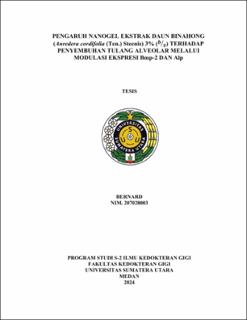| dc.description.abstract | Background: Tooth extraction can cause in considerable and prolonged alveolar bone loss, with socket wound healing falling under the category of secondary healing that necessitates an extended duration for recovery spanning the phases of hemostasis, inflammation, proliferation, and remodeling. Despite the emergence of various approaches aimed at addressing alveolar bone loss, they face limitations associated with hypersensitivity reactions, invasiveness, and cost. The use of natural products such as Binahong leaves extract has shown promising capabilities in expediting the wound healing process, as evaluated through histological, immunohistochemical, clinical, and radiographic parameters. The advancement of nanotechnology in drug delivery has made nanogels a promising system to enhance the therapeutic effectiveness of the extract. Objectives: This in vivo study evaluated the effect of 3% (b /v) Binahong leaves extract nanogel on the expression of Bmp-2, Alp, and and osteoblast differentiation during the alveolar bone healing post-tooth extraction. Methods: This study examined 30 male Wistar rats that underwent mandibular incisor extraction, subsequently being randomly allocated into two groups: one receiving the application of 3% Binahong leaves extract nanogel and the other the nanogel base. Observations on osteoblast cell count, Bmp-2, and Alp expression were conducted on socket tissues biopsied on days 7, 14, and 28, with histological and immunohistochemical assessments undertaken. The data underwent tests for normality and homogeneity, followed by analysis through one-way ANOVA and post-hoc LSD for numerical data, while categorical data related to Bmp-2 and Alp expression underwent testing via the chi-square test. Results: A significant increase (p≤0.05) in the mean number of osteoblasts between groups on days 7 and 14, although no such difference was observed on day 28. While BMP-2 expression showcased an increase within the treatment group, this elevation was not deemed statistically significant (p>0.05) across all observation periods. Notably, ALP activity demonstrated an upward trend within the treatment group, with a substantial rise (p≤0.05) noted on day 28 in comparison to the control group. Conclusion: The application of 3% (b ⁄v) Binahong leaves extract nanogel has the potential accelerate the healing process of alveolar bone after tooth extraction, as shown in osteoblasts differentiation, Bmp-2 expression, and Alp activity. | en_US |


